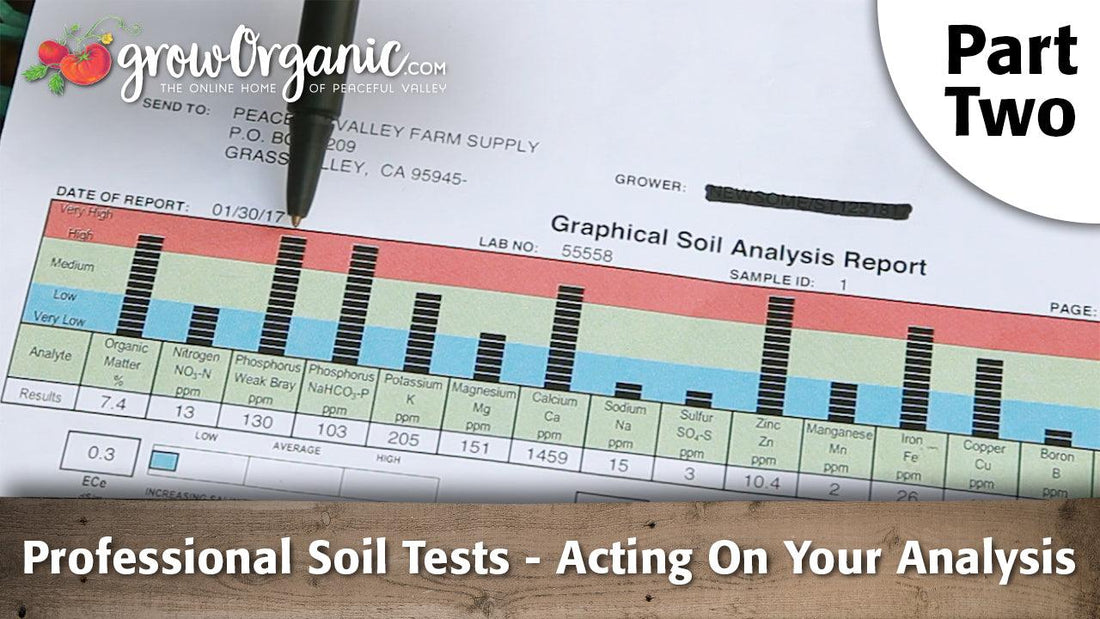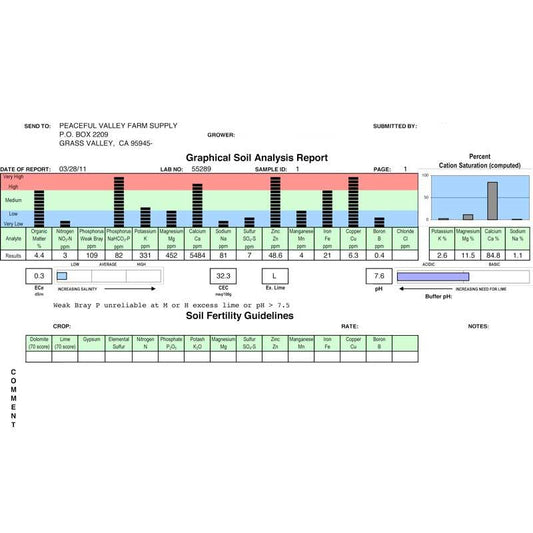Healthy soil is the foundation of a productive garden. Whether you’re growing vegetables, fruit trees, or berries, knowing your soil’s makeup is essential to achieving bountiful harvests. In Part 1–Reading Your Analysis, we explored the terms and definitions commonly found in a soil analysis report. Now, in Part 2, we’ll guide you through interpreting and acting on those results. With a focus on organic soil management, we’ll cover key nutrients, corrective actions, and how to make the most of your soil for sustainable gardening.
Organic Matter: The Foundation of Soil Health
The percentage of organic matter in your soil is one of the first and most important indicators to examine. Organic matter comes from decomposing plant material and provides multiple benefits:
- Improves Drainage: Helps prevent waterlogging.
- Increases Water Holding Capacity: Essential for water retention in sandy soils.
- Enhances Soil Aeration: Promotes root growth and microbial activity.
- Feeds the Soil Food Web: Supports beneficial microorganisms, fungi, and earthworms.
 Corrective Actions for Organic Matter
Corrective Actions for Organic Matter
- Low Organic Matter (<2%): Add high-quality organic matter such as compost, well-rotted manure, or leaf mold.
- Moderate Organic Matter (2–5%): Maintain levels with compost and encourage biological activity using soil inoculants like mycorrhizal fungi.
- High Organic Matter (>5%) with CEC <20: Avoid adding more organic matter; instead, promote biological activity with mycorrhizal soil inoculants or arctic humus.
- Very High Organic Matter (>5%) with CEC >20: Let the soil food web naturally break down excess organic matter without further amendments.
Nitrogen: The Growth Driver
Nitrogen is essential for plant growth but must be carefully managed. Both deficiencies and excesses can affect plant health and productivity.
Sources of Nitrogen
- Organic matter decomposition.
- Good sources of nitrogen like blood meal, fish meal, feather meal, guanos, and cottonseed meal.
- Nitrogen-fixing cover crops such as clover or vetch (see our video on Cover Crops for details).
When to Add Nitrogen
- Low Nitrogen (<40 ppm for vegetables, <25 ppm for trees and lawns): Add organic nitrogen sources, adjusting the type of fertilizer based on your crops. For slower release, use feather meal; for quick release, use fish meal.
- High Nitrogen (>40 ppm): Plant heavy feeders like corn, tomatoes, or squash to utilize the excess nitrogen. Avoid adding more nitrogen.
Keep in mind that most organic fertilizers also contain other nutrients, so review your entire soil analysis before selecting a nitrogen fertilizer. For example, Bio-Fish (7-7-2) provides nitrogen, phosphorus, and potassium.
 Phosphorus: Supporting Flowering, Fruiting, and Rooting
Phosphorus: Supporting Flowering, Fruiting, and Rooting
Phosphorus plays a vital role in flowering, fruit production, and root development. Soil tests often include two phosphorus readings: available phosphorus and long-term phosphorus reserves.
Sources of Phosphorus
- Bone meal.
- Rock phosphate (a slow-release option).
When to Add Phosphorus
- Low Phosphorus: Apply phosphorus early, as it is a slow-release nutrient that needs time to become available to plants.
- High Phosphorus: Avoid adding more; excessive phosphorus can harm the environment and reduce nutrient uptake efficiency.
Phosphorus is not water-soluble and should be worked into the soil to maximize availability.
Potassium: Supporting Plant Vigor
Potassium is essential for overall plant health, aiding in metabolism, water regulation, and disease resistance.
Sources of Potassium
- Sulfate of Potash (F2260).
- Potassium-containing fertilizer blends.
When to Add Potassium
- Low Potassium (<150 ppm): Add sulfate of potash to increase levels.
- High Potassium (>250 ppm) with CEC <20: Use gypsum (F1153) at a rate of 5 pounds per 100 square feet to remove excess potassium.
Cation Exchange Capacity (CEC): A Key Soil Indicator
CEC measures your soil’s ability to hold and exchange nutrients. It influences how organic matter and other nutrients interact with your soil.
- Low CEC (<10): Indicates sandy soils with limited nutrient-holding capacity. Regularly add compost to improve CEC.
- Moderate CEC (10–20): Ideal for many crops, requiring balanced amendments.
- High CEC (>20): Common in clay soils, where over-amending can lead to nutrient imbalances.
Putting It All Together
When analyzing your soil test results, consider how nutrients and organic matter interact. For example, high organic matter may tie up nitrogen temporarily, requiring slower-release fertilizers. Similarly, balancing phosphorus and potassium is crucial to prevent nutrient lockout.
Once you’ve identified your soil’s specific needs, the next step is choosing the right products to amend and improve it. Explore our wide selection of Fertilizers & Growing Supplies to find high-quality organic amendments, soil conditioners, and tools to support healthy soil management and thriving plants.
Additional Tips for Soil Management
- Test Regularly: Conduct soil tests annually or biennially to track changes and adjust amendments as needed.
- Focus on Crop Needs: Tailor nutrient levels to the specific requirements of your plants. Leafy greens, for example, need more nitrogen than root crops.
- Rotate Crops: Practice crop rotation to prevent nutrient depletion and reduce pest pressure.
- Monitor pH: Soil pH affects nutrient availability. Adjust pH as necessary with lime (to raise pH) or sulfur (to lower pH).
Working with Organic Fertilizers
Most organic fertilizers provide a mix of nutrients, making it important to choose products that align with your soil’s needs. Here are some common options:
- Nitrogen: Blood meal, fish emulsion, or feather meal.
- Phosphorus: Bone meal or rock phosphate.
- Potassium: Sulfate of potash or greensand.
- Multi-Nutrient Blends: Products like Bio-Fish offer balanced nutrition for general use.
Why Organic Soil Management Matters
Using organic methods to improve your soil benefits not only your garden but also the environment. By focusing on natural amendments and sustainable practices, you:
- Enhance soil biodiversity.
- Reduce chemical runoff.
- Improve long-term soil health.
Need Help?
If you have questions about your soil analysis or need guidance on amendments, our gardening consultants are here to help. Email us at helpdesk@groworganic.com for personalized advice.
Conclusion
Understanding your soil test results is the first step toward a healthier, more productive garden. By interpreting your soil’s organic matter, nitrogen, phosphorus, and potassium levels—and tailoring your actions accordingly—you can create a thriving environment for your plants.
Start building better soil today and grow organic for life!




